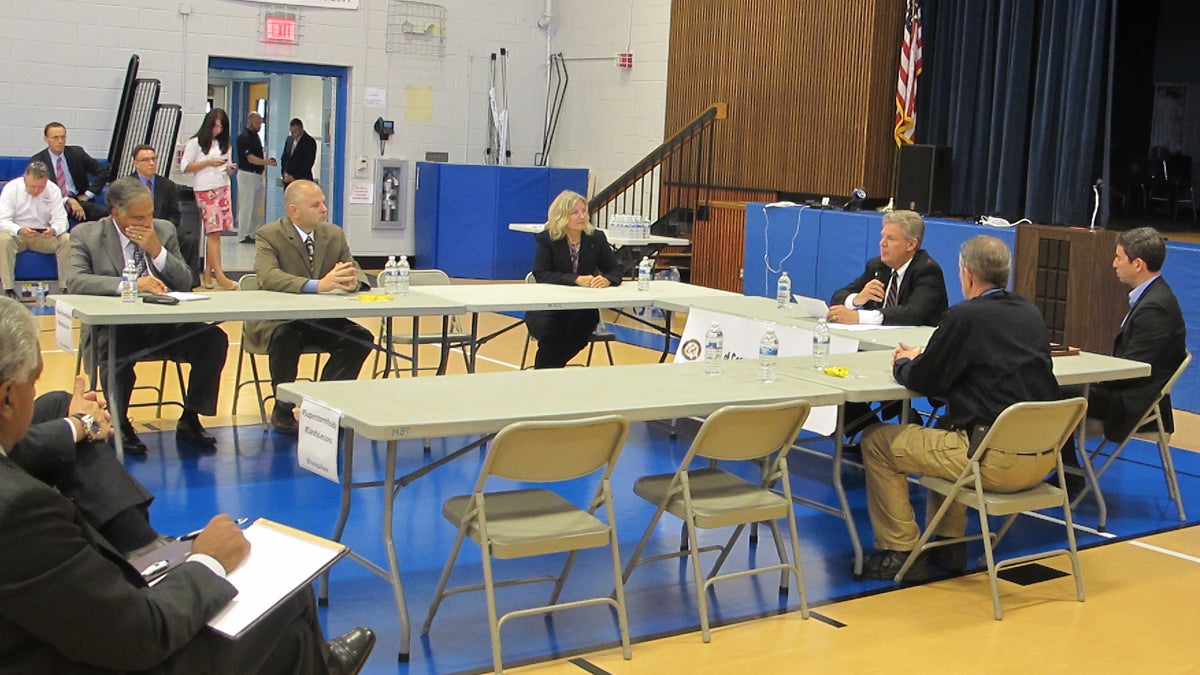Post-Sandy improvements, updates in place throughout NJ

Officials discuss post-Sandy changes at Monmouth Beach forum. (Phil Gregory/WHYY)
Attending a forum in Monmouth Beach, some New Jersey officials outlined changes since Superstorm Sandy that are intended to prevent problems from future storms.
Middlesex County has upgraded its communications system so police, fire and EMT crews in all of the towns can easily talk with one another during emergencies, said John Ferguson, the county’s emergency management director.
Aberdeen Mayor Fred Tagliarini said his town has also made some changes as a result of problems encountered during Sandy
“We’ve made it job one that our police, fire, and [community emergency response teams] communicate. We’ve improved our heating stations. We have our firehouses now with generators,” he said. “Every time we made repairs to first-aid buildings, we make sure there are generators there.”
Monmouth Beach Mayor Susan Howard noted that some residents were reluctant to evacuate as Sandy approached, and she offered a change for the future.
“The one thing I really would like to see happen the next time we have a storm is we declare a state of emergency, that we bring in the National Guard immediately — as is done in the Carolinas — so people know we are serious, and that we really do have a problem,” she said.
The local officials said they’ve also increased their use of social media as another way of keeping residents informed.
Companies supplying electric power in New Jersey are trying to improve the reliability of the system after Sandy knocked out service for millions of residents nearly three years ago.
Jersey Central Power and Light and PSE&G are elevating the electric equipment in substations that were flooded during Sandy, building walls around those facilities, or moving the stations elsewhere.
Ananda Kanapathy, the senior director of asset strategy for PSE&G, said electric circuits are being reconfigured to 36 fuel depots to prevent problems with the gasoline supply in future storms.
“In the event you have another Sandy type event and the primary source of supply is lost, we should be able to pick them up with a third supply in a relatively short period of time and not have those lengthy outages to those fuel depots,” he said.
PSE&G has enhanced its power outage maps to provide more information to residents, Kanapathy said.
“There’s greater detail in our outage maps. Start time of outages, customers affected, anticipated restoration time, percentages of customers, and so forth,” he said.
Tony Hurley, vice president of operations for JCPL, said the utility is taking steps to prevent tree limbs from bringing down power lines.
“Especially in areas where we know we have a critical customer — like a radio station or a hospital — getting a little more aggressive on the tree trimming, so that when you take a look at the number of trees that cover up, especially on private property, being able to address that,” Hurley said.
U.S. Rep. Frank Pallone, D-New Jersey, said all the changes implemented since Sandy hit will help ease problems during future emergencies.
“It’s clear that if you had another storm like Sandy that a lot of inoperability problems, a lot of the fuel problems for example, wouldn’t be there. But, of course, the problem is: Is the next storm Sandy or is it going to be worse than Sandy?”
WHYY is your source for fact-based, in-depth journalism and information. As a nonprofit organization, we rely on financial support from readers like you. Please give today.




